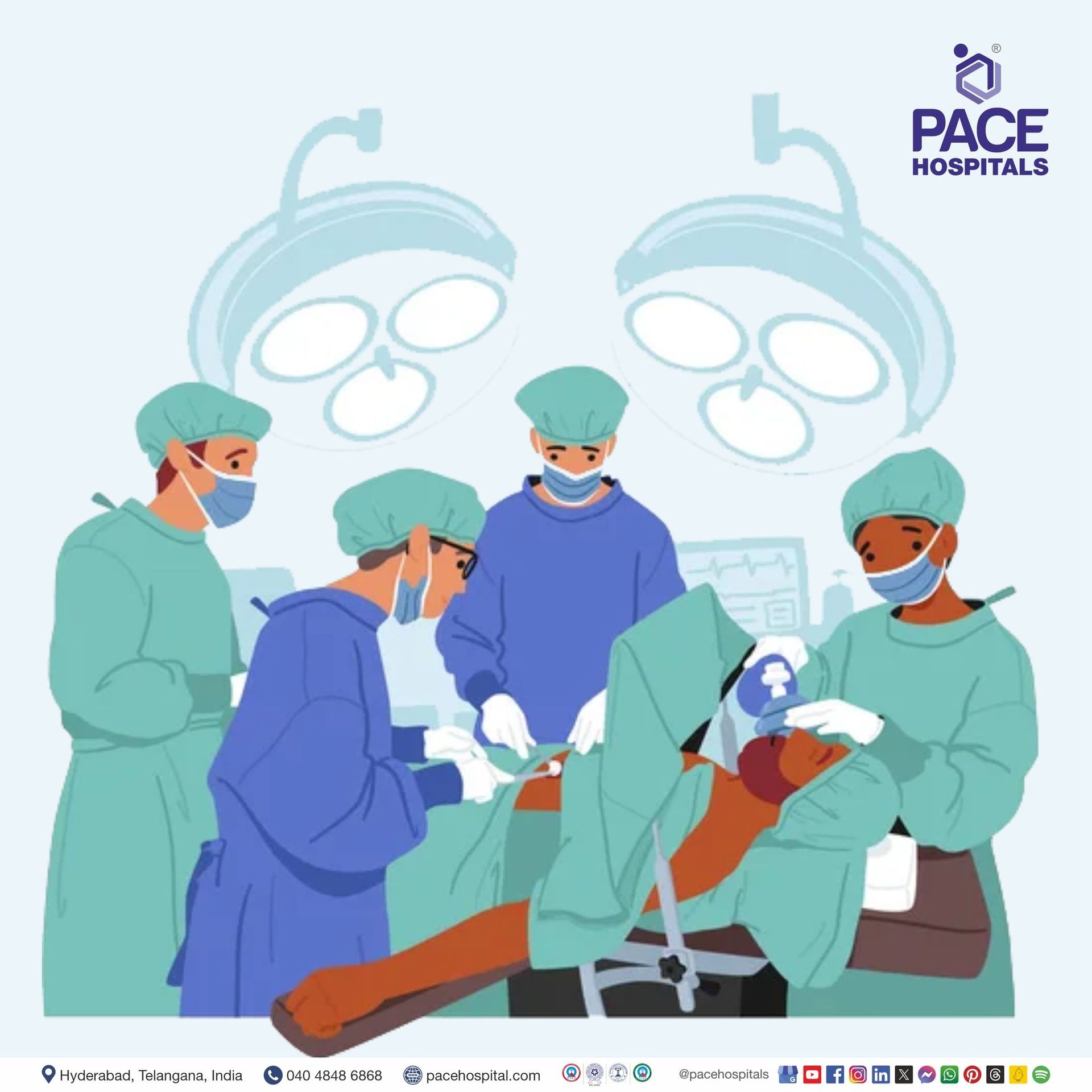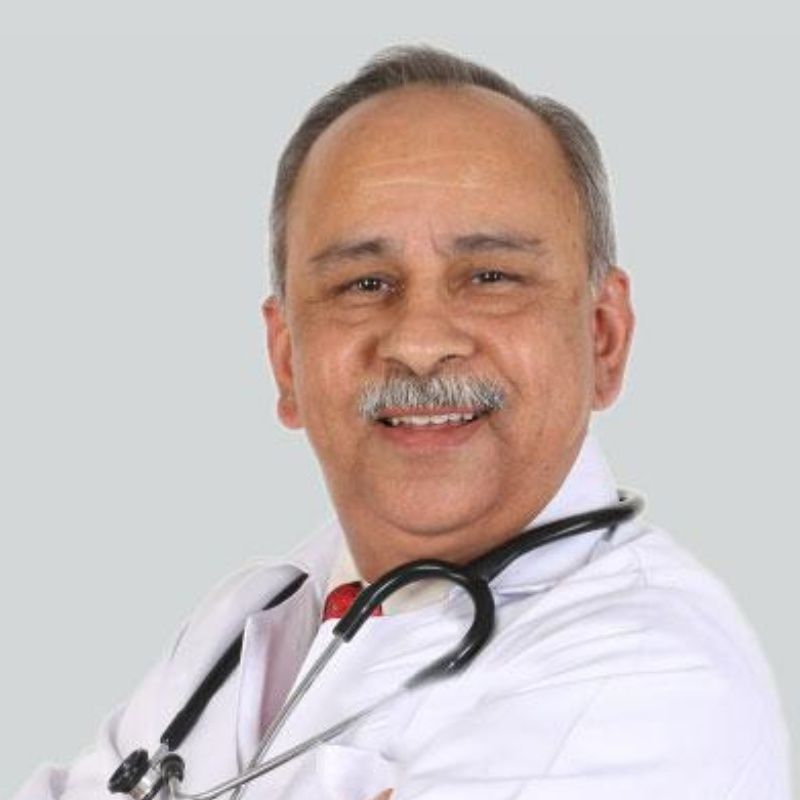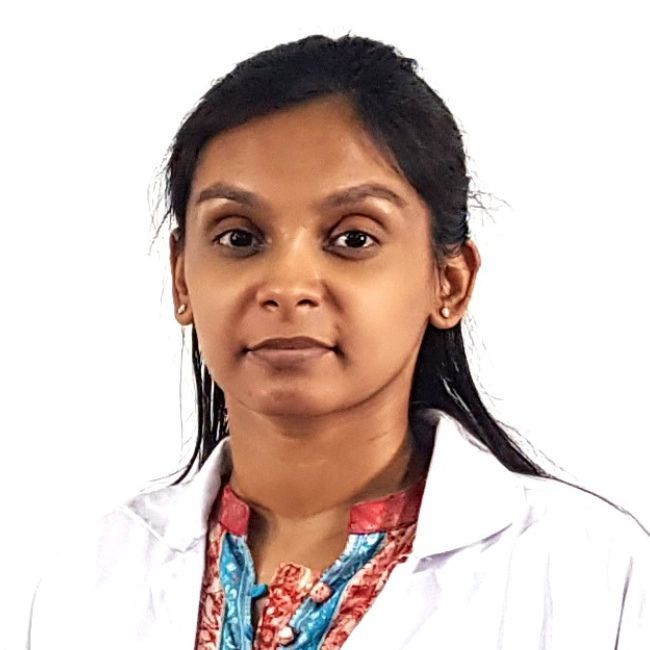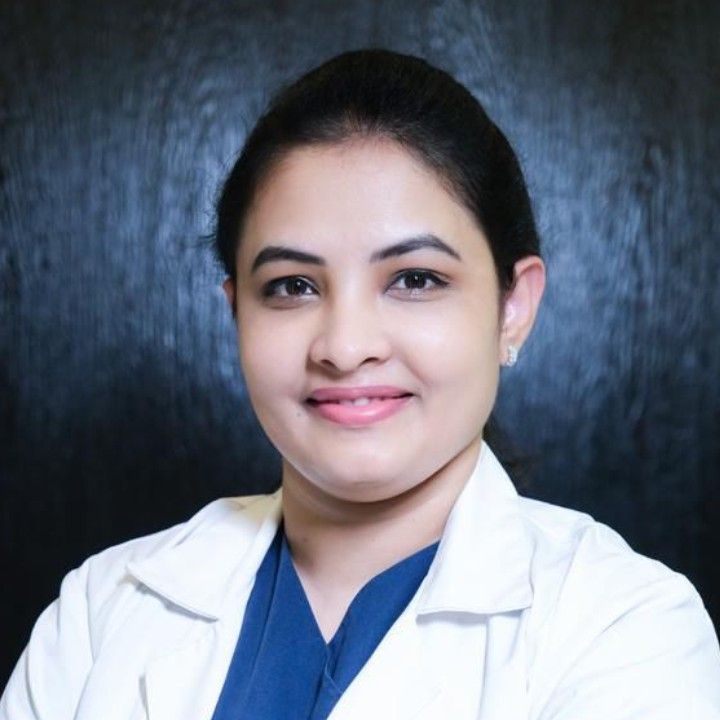Best General Surgery Hospital in Hyderabad
PACE Hospitals is one of the best general surgery hospital in Hyderabad, staffed with the experienced and skilled general surgeon, pediatric general surgeon, capable of performing minimally invasive as well as complex general surgery procedures for all the conditions related to digestive system, glands, breast, skin and soft tissue. Common general surgery procedures performed are:
- Herniorrhaphy & Hernioplasty (Hernia repair Surgery)
- Cholecystectomy (Gallstone removal)
- Appendectomy (Appendix removal)
- Gastrectomy (Partial or Total removal of stomach)
- Splenectomy (Spleen removal)
- Colectomy (Part of colon removal)
- Thyroidectomy (Thyroid removal)
- Mastectomy (Removal of one or both breast)
- Lymph Node Dissection
Why to choose us?
Comprehensive Surgical Care
Providing surgical care to a wide range of medical conditions including digestive system, glands, breast, skin and soft tissue.
Advanced State-of-the-art Facility
Equipped with advanced robotic, laparoscopic surgical facilities and latest diagnostic equipments to cater diverse medical conditions.
Skilled & Experienced General Surgeons
Team of experienced general surgeons & general surgery specialist with vast experience in lasers and laparoscopic surgeries.
Advanced General Surgery Centre in Hyderabad, Telangana

The general surgery department in PACE Hospitals is equipped with state-of-the-art surgical facilities with latest surgical & screening equipment to cater evidence-based and precise surgical treatment to minimize the risks during and post-surgery. It also follows an advanced strategy for pain management to provide minimum discomfort to the patient post-surgery.
The team of general surgeon doctor at PACE Hospitals have a wide range of surgical expertise to handle complex conditions through different surgical modalities like open, laparoscopic, or robotic surgeries based on the condition complexities. Along with surgical expertise, general surgeon focuses on a patient-centric approach to furnish the patient with pre- and post-operative guidelines and educate them about the benefits, complications, and expected outcomes of the surgery.
3,12,338
98,538
684
2011
Best General Surgery Doctor in Hyderabad - Hitec City & Madinaguda
PACE Hospitals is proud to be home to some of the best general surgery doctors in Hyderabad. Our team of highly skilled and experienced surgeons is dedicated to providing the highest level of care to our patients. We use the advanced techniques and technology to ensure the best possible outcomes for our patients. Our surgeons are experts in a wide range of procedures, including laser surgery, laparoscopic surgery, minimally invasive surgery, and robotic surgery. We are committed to ensuring that our patients receive the best possible care and are here to support them every step of the way. Whether you are in need of a routine surgery or a complex procedure, you can trust the team at PACE Hospitals to provide the expert care you need.
Diseases and Conditions Explained by Drs
Need Help?
Planning for upcoming surgeries related to Gallbladder, Hernias, Appendix, Breast Conditions, Colorectal, Thyroid & Parathyroid Disorders, Gastrointestinal Disorders, Soft Tissue Tumors, and other medical conditions and seeking assistance and information on pre-operative and post-operative care about the specific surgical procedure, our team of skilled and experienced general surgery doctor guide you with comprehensive consultation and compassionate surgical care throughout your surgical journey. General surgery specialists at PACE Hospitals are well versed with the latest and advanced minimally invasive surgical techniques, providing precise, efficient, and highest quality of care in a safe environment.
What we treat?
General Surgery Specialist at PACE Hospitals expertise in diagnosing and surgically managing a diverse range of medical conditions, including digestive system disorders, endocrine system disorders, breast conditions, skin, and soft tissue conditions, vascular conditions, trauma & emergency, and other conditions to ensure patients get extensive and compassionate surgical care for a wide array of medical conditions.

Patient Testimonials
Patient with the complaint of recurrent Bile duct stone treated successfully with Hepaticojejunostomy Procedure.
Patients with a BMI of 52 along with Obstructive sleep apnea (OSA) and diabetes was treated successfully with gastric bypass surgery.
A Patient with multiple pancreatic ductal stones was successfully treated with pancreatic sphincterotomy.
General Surgery Procedures Performed
We offer a wide range of common and complex surgical procedures to treat various medical conditions related to the abdomen, digestive tract, endocrine system, skin, and other organs. The General Surgery Department at PACE Hospitals is equipped with advanced and latest surgical equipment and a highly skilled and experienced team of general surgery doctors to deliver patient-centric and evidence-based surgical care to patients.

1. Appendectomy: Appendectomy is a procedure that is performed to remove the appendix, commonly in the case of appendicitis (inflamed appendix). It can be accomplished through open surgery or laparoscopically. This procedure helps in reducing pain and prevents further complications like rupture of the appendix.
2. Cholecystectomy: Cholecystectomy procedure is the surgical removal of the gallbladder that can be accomplished through open surgery or minimally invasive laparoscopic techniques. This surgery is commonly indicated in the case of gallbladder lumps and gallstones causing severe pain and infections. This procedure helps in relieving the symptoms like severe abdominal pain, nausea, and digestive issues.
3. Herniorrhaphy (Hernia Repair): Medications cannot fix hernias. Hence, most hernias require surgery. Herniorrhaphy is the surgical procedure to fix a hernia. A general surgeon may recommend surgery if the patient has a growing larger hernia that is causing discomfort, disturbing daily activities, and posing a risk of bowel obstruction.
4. Skin Lesion Removal: Skin lesion removal is a surgical procedure to remove skin growths that are different from the surrounding skin. It is performed when the skin lesion is too large, uncomfortable, or bothersome. A general surgeon removes skin lesions if the person has skin lesions that could be cancerous or precancerous.
5. Breast Biopsy: A biopsy is a small piece of tissue removed to find abnormal cells in the sample. For a breast biopsy, breast tissue is obtained with a special biopsy needle or during surgery. Breast biopsies may be done to check a mass or lump that can be palpable (feel) in the breast, a fluid-filled mass (cyst), or breast tissue to find whether the breast lump or mass is malignant or not cancerous.
6. Breast Lumpectomy: Lumpectomy, also known as breast-conserving surgery (BCS), may be used as a common type of surgery, which is part of a treatment plan for breast cancer. A lumpectomy is the surgical removal of a breast lump along with the surrounding tissues while leaving as much normal breast as possible. This procedure is generally considered for early-stage breast cancer to minimize the impact on breast appearance and sensation. This surgery is sometimes also called a quandrantectomy, partial mastectomy, or segmental mastectomy, based on how much portion is removed.
7. Mastectomy: Mastectomy is surgically removing a part or complete breast. Mastectomy is classified into partial, simple, modified-radical, and radical. During a mastectomy, usually, the surgeon removes all the breast tissue and also some underarm lymph nodes in case the cancer has spread beyond the breast. There are different types of mastectomy. Doctors and patients must work together to decide which surgery is best based on the patient's situation.
8. Breast Reconstruction: Breast reconstruction is the surgical procedure that is performed to recreate breasts. This surgery aims to restore one or both breasts to near-normal appearance, size, shape, and symmetry.
Breast reconstruction generally falls into two categories:
- Implant reconstruction: It involves the use of breast implants to construct a new breast mound.
- Flap (or autologous) reconstruction: It involves using the patient's own tissue from another part of the body to form a new breast.
9. Colectomy: A colectomy, also called a large bowel resection, is a type of surgery used to treat colon conditions, including cancer, diverticulitis, or inflammatory disease, by removing a part of the colon. This surgery is also performed if colon cancer is in its earlier stages. Removal of the colon may be done in the following ways:
- Proctocolectomy: This procedure is utilized to remove the entire colon and rectum
- Subtotal colectomy: Removal of all the colon but not the rectum
- Partial colectomy: This procedure involves the removal of part of the colon but not the rectum
10. Haemorrhoidectomy: Haemorrhoidectomy is a surgery to remove severe piles (hemorrhoids). Removing the piles will relieve the uncomfortable symptoms. It is typically a day procedure and is usually carried out under a general anesthesia. The procedure is generally safe and common. However, recovery after this surgery may take a few weeks and can be painful. This surgery can be performed when non-surgical treatments don’t work.
11. Colonoscopy: Colonoscopy is a diagnostic (test) as well as a therapeutic procedure performed to examine the large intestine, including the colon, rectum, anus, and the distal portion of the small intestine. It is performed using a flexible tube-like device called a colonoscope, which has a camera placed at the tip of the scope and acts as a channel for the insertion of equipment. This diagnostic procedure detects ailments such as polyps, tumors, and inflammation. During the process, the surgeon may remove the polyp or take biopsies.
12. Colorectal Resection:
Colon resection is a surgical procedure performed to remove either a portion or an entire colon based on the underlying cause of the disease that necessitates the removal. Colon and rectal surgeries are usually performed to treat some conditions, including inflammatory bowel disease or diverticulitis and colon and rectal cancers, and may also be necessary following a bowel blockage, injury or wound, or serious infection.
13. Debridement of Wound, Burn or Infection: Debridement (removal of nonviable (necrotic or dead) tissue) and wound dressings are utilized to reduce the infection risk and provide comfort in minor, wounds, burns or infections. It is a procedure for treating a wound in the skin. It involves cleaning the wound thoroughly and removing all thickened skin or callus (hyperkeratotic skin), infected and nonviable (necrotic or dead) tissue, foreign debris, and residual material from dressings.
14. Thyroidectomy: Thyroidectomy is the surgical removal of a partial or complete thyroid gland. This surgery is used to treat conditions including thyroid cancer, thyroid nodules, and other thyroid conditions. Once the thyroid is removed, the patient is recommended to take a replacement thyroid hormone to keep the body functioning balanced.
15. Parathyroidectomy: Surgical removal of the parathyroid glands is called Parathyroidectomy. Problems affecting the parathyroid glands may cause an imbalance of calcium and require the removal of one or more glands. Parathyroid gland problems such as hyperparathyroidism, parathyroid nodules, and parathyroid tumours can be treated using this surgical procedure.
16. Gastric Bypass Surgery: Gastric bypass surgery is a kind of bariatric or weight loss surgery. It aids people with obesity in losing weight and improving their health. It reduces the size of the stomach and modifies how the small intestine and stomach absorb food, making it easier to lose weight. In this surgery, the surgeon makes the patient's stomach smaller and connects it directly to the small intestine, bypassing part of the patient's digestive tract.
17. Abscess Incision and Drainage: Incision and drainage (I and D) are widely used procedures in various areas, including emergency departments and outpatient clinics. They are a primary treatment for skin and soft tissue abscesses. A cut is made on the skin over the abscess to drain out the pus, and the skin opening is left open to allow the cavity to heal upwards from the inside out.
18. Parotidectomy: The parotid gland is the largest major salivary gland. Parotidectomy is the complete or partial removal of the parotid gland, and it may be performed for various reasons, including inflammatory conditions, specific infectious processes, congenital malformations, and benign (non-cancerous) or malignant (cancerous) neoplasms.
19. Distal Pancreatectomy: Pancreatectomy is a surgical procedure to remove a part or complete pancreas. It is generally done to treat cancer and, sometimes, severe chronic pancreatitis. In distal pancreatectomy, the distal part (body or tail) of the pancreas will be removed. The spleen may also be removed. This procedure treats conditions including tumors (benign or malignant) found in the body or tail of the pancreas.
20. Esophagectomy: Esophagectomy is the surgery to remove the esophagus (food pipe), the tube that moves food from the throat to the stomach. After the esophagus is removed, a new esophagus is rebuilt from part of the patient's stomach or part of the large intestine by pulling up and joining it with the remaining esophagus. It is indicated to treat esophageal cancer.
21. Gastrectomy: A gastrectomy is a surgical procedure involving removing part or complete stomach. A gastrectomy is often indicated to treat stomach cancer. Less commonly, it is used to treat esophageal cancer, stomach ulcers (peptic ulcers), life-threatening obesity, and non-cancerous tumors. It is usually an effective treatment for obesity and cancer.
22. Heller Myotomy: A heller myotomy or esophageal myotomy is a surgical procedure to open the tight lower esophageal sphincter that fails to relax (e.g., achalasia, a disorder of the esophagus that makes it tough for foods and liquids to pass into the stomach). The procedure involves a vertical incision of the distal esophageal musculature to break the sphincter tone.
23: Hepatic Artery Embolization: Embolization is a procedure used to treat liver tumors by blocking their blood supply. It injects substances directly into an artery in the liver to stop or reduce the blood flow to a tumor. It is an option for some patients with tumors that cannot be removed by surgery and for tumors that are too large and who also have adequate liver function.
24. Ostomy surgery: An ostomy is a surgical procedure to create an opening (stroma) in the abdomen, changing the way that waste exists in a person's body. In this procedure, a surgeon brings the part of the bowel (intestine) through the abdominal wall so that intestinal contents leave the body through the abdominal wall instead of passing through the anus.
There are many different types of ostomy, they may include as follows:
- Ileostomy: In this procedure, the bottom of the small intestine will be attached to the stoma (the connection between an internal organ and the skin outside the body).
- Colostomy: In this procedure, the colon will be attached to the stoma to bypass the rectum and the anus.
Why to choose PACE Hospitals?
- 150+ bedded super speciality hospital, CGHS & ISO accreditation.
- NABH and NABL accreditation.
- State-of-the-art Liver and Kidney transplant centre.
- Empanelled with all TPA’s for smooth cashless benefits.
- Centralized HIMS (Hospital Information System).
- Computerized health records available via website.
- Minimum waiting time for Inpatient and Outpatient.
- Round-the-clock guidance from highly qualified urology surgeons and physicians.
- Standardization of ethical medical care.
- 24X7 Outpatient & Inpatient Pharmacy Services.
- State-of-the-art operation theaters.
- Intensive Care Units (Surgical and Medical) with ISO-9001 accreditation.












